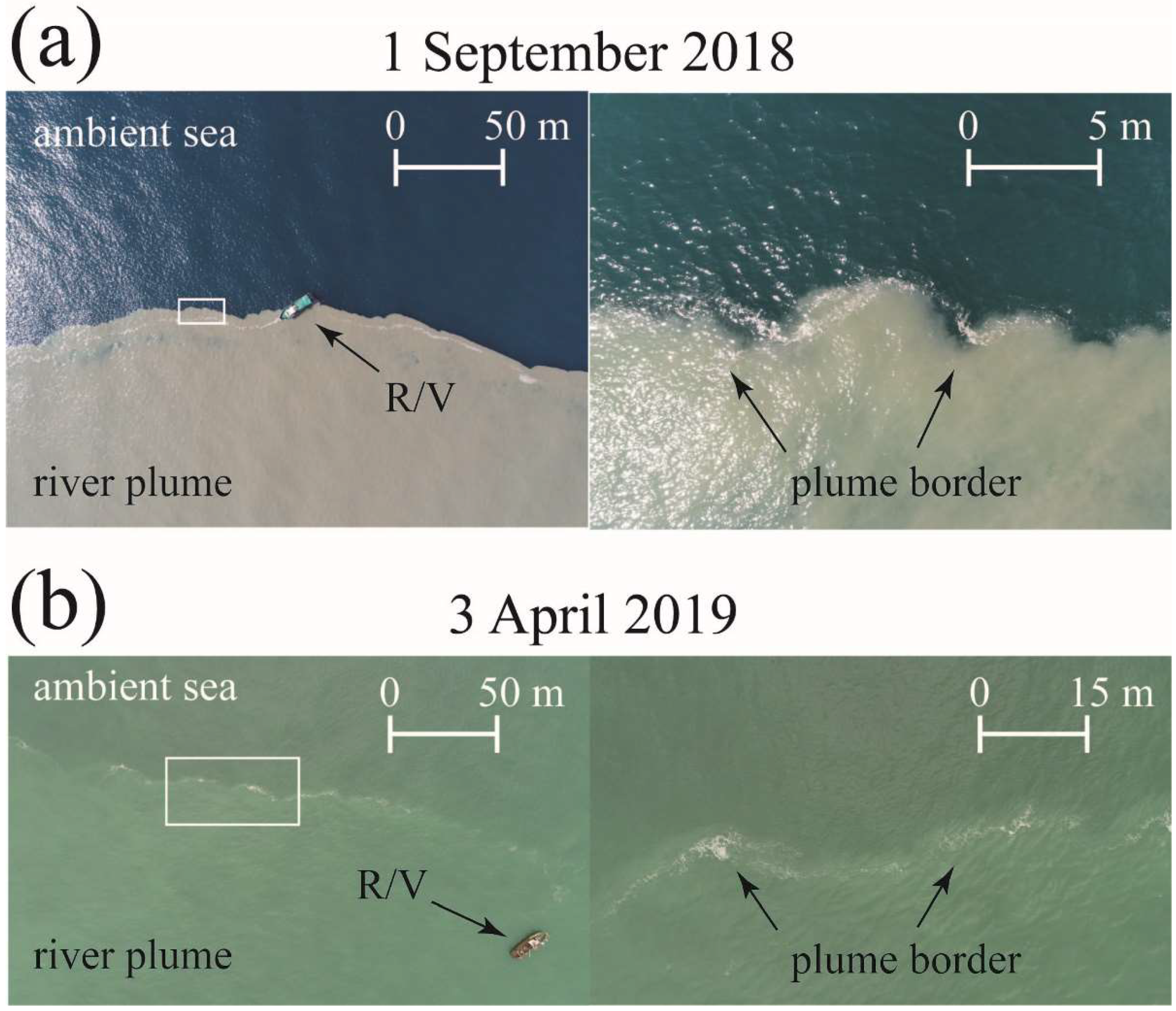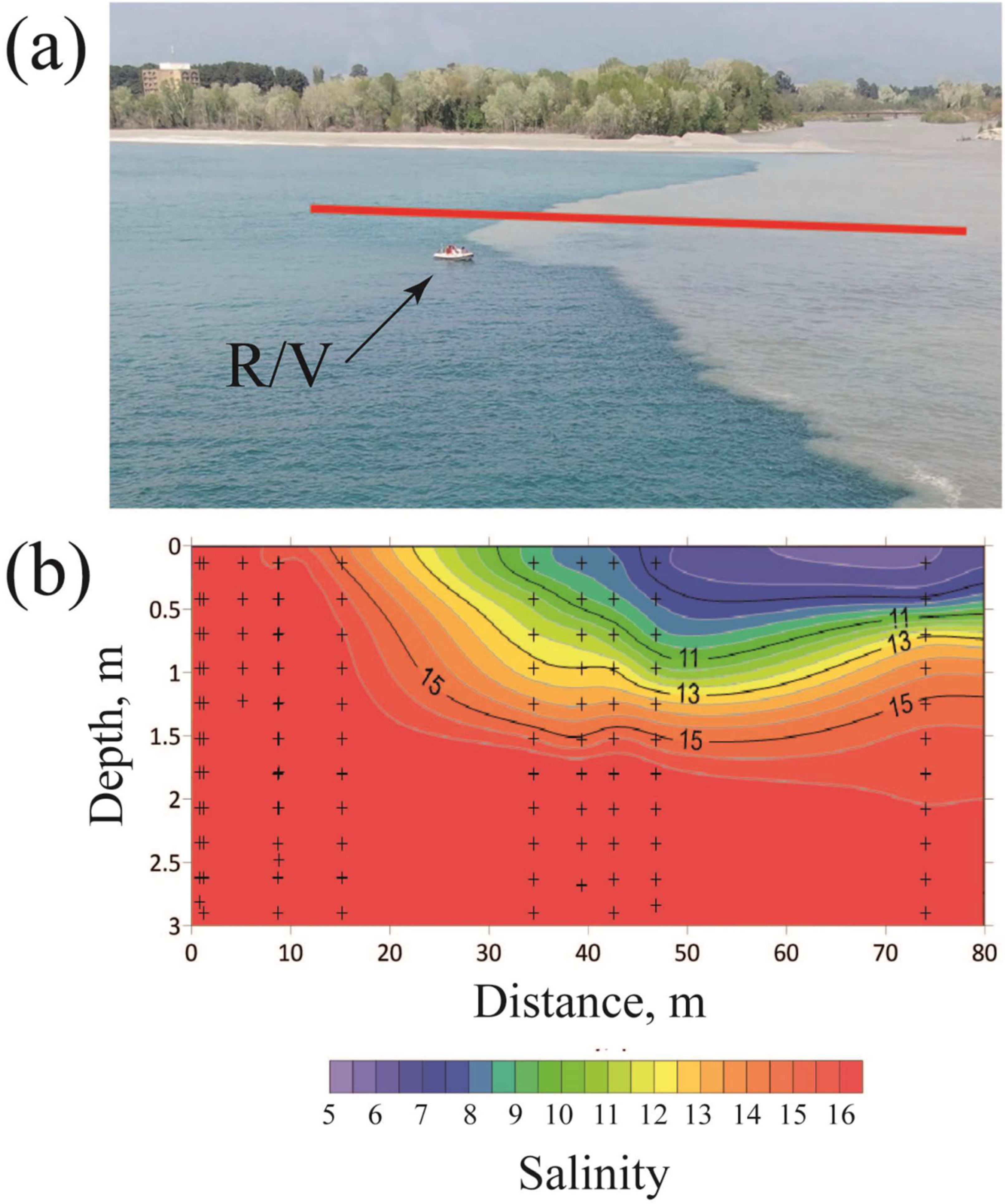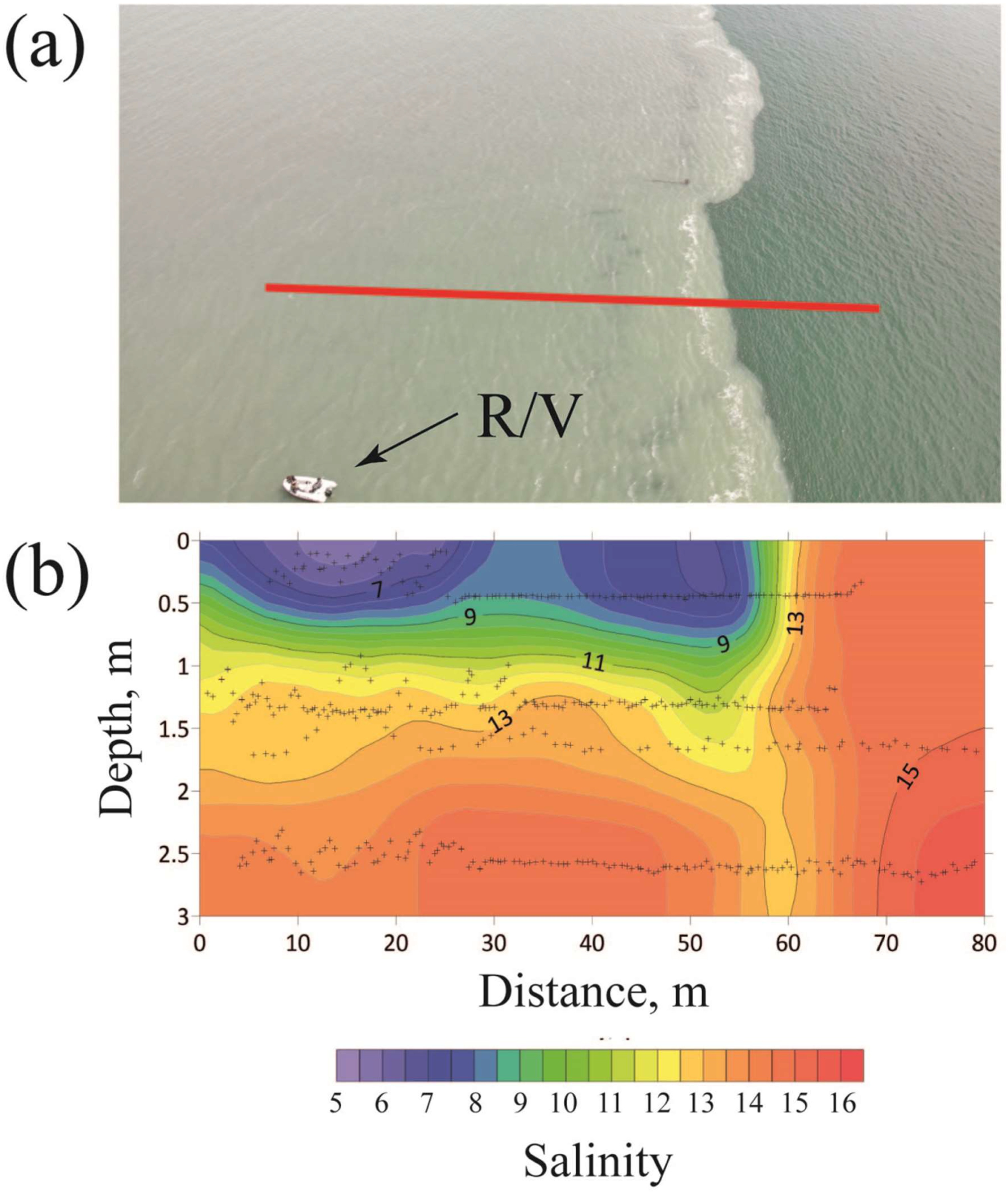Lateral Border of a Small River Plume: Salinity Structure, Instabilities and Mass Transport
Abstract
:1. Introduction
2. Data and Methods
2.1. Aerial Observations and In Situ Measurements
2.2. Processing of Aerial Data
3. Results
4. Discussion
5. Conclusions
Author Contributions
Funding
Data Availability Statement
Conflicts of Interest
References
- Korotkina, O.A.; Zavialov, P.O.; Osadchiev, A.A. Synoptic variability of currents in the coastal waters of Sochi. Oceanology 2014, 54, 545–556. [Google Scholar] [CrossRef]
- Osadchiev, A.A.; Barymova, A.A.; Sedakov, R.O.; Zhiba, R.Y.; Dbar, R.S. Spatial structure, short-temporal variability, and dynamical features of small river plumes as observed by aerial drones: Case study of the Kodor and Bzyp river plumes. Remote Sens. 2020, 12, 3079. [Google Scholar] [CrossRef]
- Osadchiev, A.A.; Barymova, A.A.; Sedakov, R.O.; Rybin, A.V.; Tanurkov, A.G.; Krylov, A.A.; Kremenetskiy, V.V.; Mosharov, S.A.; Polukhin, A.A.; Ulyantsev, A.S.; et al. Hydrophysical structure and current dynamics of the Kodor river plume. Oceanology 2021, 61, 1–14. [Google Scholar] [CrossRef]
- Osadchiev, A.A.; Sedakov, R.O.; Barymova, A.A. Response of a small river plume on wind forcing. Front. Mar. Sci. 2021, 8, 809566. [Google Scholar] [CrossRef]
- McPherson, R.A.; Stevens, C.L.; O’Callaghan, J.M.; Lucas, A.J.; Nash, J.D. The role of turbulence and internal waves in the structure and evolution of a near-field river plume. Ocean Sci. 2020, 16, 799–815. [Google Scholar] [CrossRef]
- Osadchiev, A.A.; Sedakov, R.O.; Gordey, A.S.; Barymova, A.A. Internal waves as a source of concentric rings within small river plumes. Remote Sens. 2021, 13, 4275. [Google Scholar] [CrossRef]
- Juul-Pedersen, T.; Michel, C.; Gosselin, M. Influence of the Mackenzie River plume on the sinking export of particulate material on the shelf. J. Mar. Syst. 2018, 74, 810–824. [Google Scholar] [CrossRef]
- Orpin, A.R.; Ridd, P.V. Exposure of inshore corals to suspended sediments due to wave-resuspension and river plumes in the central Great Barrier Reef: A reappraisal. Cont. Shelf Res. 2012, 47, 55–67. [Google Scholar] [CrossRef]
- Korotenko, K.A.; Osadchiev, A.A.; Zavialov, P.O.; Kao, R.-C.; Ding, C.-F. Effects of bottom topography on dynamics of river discharges in tidal regions: Case study of twin plumes in Taiwan Strait. Ocean Sci. 2014, 10, 865–879. [Google Scholar] [CrossRef] [Green Version]
- Lee, J.; Liu, J.T.; Hung, C.C.; Lin, S.; Du, X. River plume induced variability of suspended particle characteristics. Mar. Geol. 2016, 380, 219–230. [Google Scholar] [CrossRef]
- Osadchiev, A.A.; Korotenko, K.A.; Zavialov, P.O.; Chiang, W.-S.; Liu, C.-C. Transport and bottom accumulation of fine river sediments under typhoon conditions and associated submarine landslides: Case study of the Peinan River, Taiwan. Nat. Hazards Earth Syst. Sci. 2016, 16, 41–54. [Google Scholar] [CrossRef] [Green Version]
- Salmela, J.; Kasvi, E.; Alho, P. River plume and sediment transport seasonality in a non-tidal semi-enclosed brackish water estuary of the Baltic Sea. Estuar. Coast. Shelf Sci. 2020, 245, 106986. [Google Scholar] [CrossRef]
- Payandeh, A.R.; Justic, D.; Mariotti, G.; Huang, H.; Valentine, K.; Walker, N.D. Suspended sediment dynamics in a deltaic estuary controlled by subtidal motion and offshore river plumes. Estuar. Coast. Shelf Sci. 2021, 250, 107137. [Google Scholar] [CrossRef]
- Korshenko, E.A.; Zhurbas, V.M.; Osadchiev, A.A.; Belyakova, P.A. Fate of river-borne floating litter during the flooding event in the northeastern part of the Black Sea in October 2018. Mar. Pollut. Bull. 2020, 160, 111678. [Google Scholar] [CrossRef]
- Zhang, Z.; Wu, H.; Peng, G.; Xu, P.; Li, D. Coastal ocean dynamics reduce the export of microplastics to the open ocean. Sci. Total Environ. 2020, 713, 136634. [Google Scholar] [CrossRef]
- Zavialov, P.O.; Moller, O.O., Jr.; Wang, X.H. Relations between marine plastic litter and river plumes: First results of PLUMPLAS project. J. Oceanol. Res. 2020, 48, 32–44. [Google Scholar] [CrossRef]
- Pakhomova, S.; Berezina, A.; Lusher, A.L.; Zhdanov, I.; Silvestrova, K.; Zavialov, P.; van Bavel, B.; Yakushev, E. Microplastic variability in subsurface water from the Arctic to Antarctica. Environ. Pollut. 2022, 298, 118808. [Google Scholar] [CrossRef]
- Grimes, C.B.; Kingsford, M.J. How do riverine plumes of different sizes influence fish larvae: Do they enhance recruitment? Mar. Freshw. Res. 1996, 47, 191–208. [Google Scholar] [CrossRef]
- Vargas, C.A.; Narváez, D.A.; Piñones, A.; Navarrete, S.A.; Lagos, N.A. River plume dynamic influences transport of barnacle larvae in the inner shelf off central Chile. J. Mar. Biol. Assoc. 2006, 86, 1057–1065. [Google Scholar] [CrossRef]
- Axler, K.E.; Sponaugle, S.; Briseño-Avena, C.; Hernandez, F., Jr.; Warner, S.J.; Dzwonkowski, B.; Dykstra, S.L.; Cowen, R.K. Fine-scale larval fish distributions and predator-prey dynamics in a coastal river-dominated ecosystem. Mar. Ecol. Prog. Ser. 2015, 650, 37–61. [Google Scholar] [CrossRef]
- Pattrick, P.; Weidberg, N.; Goschen, W.S.; Jackson, J.M.; McQuaid, C.D.; Porri, F. Larval fish assemblage structure at coastal fronts and the influence of environmental variability. Front. Ecol. Evol. 2021, 9, 684502. [Google Scholar] [CrossRef]
- O’Donnell, J.; Marmorino, G.O.; Trump, C.L. Convergence and downwelling at a river plume front. J. Phys. Oceanogr. 1998, 28, 1481–1495. [Google Scholar] [CrossRef]
- MacDonald, D.G.; Geyer, W.R. Turbulent energy production and entrainment at a highly stratified estuarine front. J. Geophys. Res. 2004, 109, C05004. [Google Scholar] [CrossRef] [Green Version]
- Orton, P.M.; Jay, D.A. Observations at the tidal plume front of a high-volume river outflow. Geophys. Res. Lett. 2005, 32, L11605. [Google Scholar] [CrossRef] [Green Version]
- MacDonald, D.G.; Goodman, L.; Hetland, R.D. Turbulent dissipation in a near-field river plume: A comparison of control volume and microstructure observations with a numerical model. J. Geophys. Res. 2007, 112, C07026. [Google Scholar] [CrossRef] [Green Version]
- O’Donnell, J.; Ackleson, S.G.; Levine, E.R. On the spatial scales of a river plume. J. Geophys. Res. 2008, 113, C04017. [Google Scholar] [CrossRef] [Green Version]
- McCabe, R.M.; Hickey, B.M.; MacCready, P. Observational estimates of entrainment and vertical salt flux in the interior of a spreading river plume. J. Geophys. Res. 2008, 113, C08027. [Google Scholar] [CrossRef] [Green Version]
- Kilcher, L.F.; Nash, J.D.; Moum, J.N. The role of turbulence stress divergence in decelerating a river plume. J. Geophys. Res. Oceans 2012, 117, C05032. [Google Scholar] [CrossRef] [Green Version]
- Trump, C.L.; Marmorino, G.O. Mapping small-scale along-front structure using ADCP acoustic backscatter range-bin data. Estuaries 2003, 26, 878–884. [Google Scholar] [CrossRef]
- Tedford, E.W.; Carpenter, J.R.; Pawlowicz, R.; Pieters, R.; Lawrence, G.A. Observation and analysis of shear instability in the Fraser River estuary. J. Geophys. Res. Oceans 2009, 114, C11006. [Google Scholar] [CrossRef] [Green Version]
- Warrick, J.A.; Stevens, A.W. A buoyant plume adjacent to a headland—Observations of the Elwha River plume. Continent. Shelf Res. 2011, 31, 85–97. [Google Scholar] [CrossRef]
- Horner-Devine, A.; Chickadel, C.C.; MacDonald, D. Coherent structures and mixing at a river plume front. In Coherent Flow Structures in Geophysical Flows at the Earth’s Surface; Venditti, J., Best, J.L., Church, M., Hardy, R.J., Eds.; Wiley: Chichester, UK, 2013; pp. 359–369. [Google Scholar] [CrossRef]
- Horner-Devine, A.R.; Chickadel, C.C. Lobe-cleft instability in the buoyant gravity current generated by estuarine outflow. Geophys. Res. Lett. 2017, 44, 5001–5007. [Google Scholar] [CrossRef]
- Iwanaka, Y.; Isobe, A. Tidally induced instability processes suppressing river plume spread in a nonrotating and nonhydrostatic regime. J. Geophys. Res. Oceans 2018, 123, 3545–3562. [Google Scholar] [CrossRef]
- Shi, J.; Tong, C.; Zheng, J.; Zhang, C.; Gao, X. Kelvin–Helmholtz billows induced by shear instability along the North Passage of the Yangtze River Estuary, China. J. Mar. Sci. Eng. 2019, 7, 92. [Google Scholar] [CrossRef] [Green Version]
- Ayouche, A.; Carton, X.; Charria, G. Vertical shear processes in river plumes: Instabilities and turbulent mixing. Symmetry 2022, 14, 217. [Google Scholar] [CrossRef]
- Garvine, R.W. Physical features of the Connecticut River outflow during high discharge. J. Geophys. Res. 1974, 79, 831–846. [Google Scholar] [CrossRef]
- Venditti, J.G.; Hardy, R.J.; Church, M.; Best, J.L. What is a coherent flow structure in geophysical flow? In Coherent Flow Structures in Geophysical Flows at the Earth’s Surface; Venditti, J., Best, J.L., Church, M., Hardy, R.J., Eds.; Wiley: Chichester, UK, 2013; pp. 1–16. [Google Scholar] [CrossRef]
- Parsons, J.D.; García, M.H. Similarity of gravity current fronts. Phys. Fluids 1998, 10, 3209. [Google Scholar] [CrossRef]
- Dai, A.; Huang, Y. On the merging and splitting processes in the lobe-and-cleft structure at a gravity current head. J. Fluid Mech. 2022, 930, A6. [Google Scholar] [CrossRef]
- Simpson, A.J.; Shi, F.; Jurisa, J.T.; Honegger, D.A.; Hsu, T.-J.; Haller, M.C. Observations and modeling of a buoyant plume exiting into a tidal cross-flow and exhibiting along-front instabilities. J. Geophys. Res. Oceans 2022, 127, e2021JC017799. [Google Scholar] [CrossRef]
- MacDonald, D.G.; Carlson, J.; Goodman, L. On the heterogeneity of stratified-shear turbulence: Observations from a near-field river plume. J. Geophys. Res. Oceans 2013, 118, 6223–6237. [Google Scholar] [CrossRef]
- Fisher, A.W.; Nidzieko, N.J.; Scully, M.E.; Chant, R.J.; Hunter, E.J.; Mazzini, P.L.F. Turbulent mixing in a far-field plume during the transition to upwelling conditions: Microstructure observations from an AUV. Geophys. Res. Lett. 2018, 45, 9765–9773. [Google Scholar] [CrossRef]
- Ayouche, A.; Carton, X.; Charria, G.; Theettens, S.; Ayoub, N. Instabilities and vertical mixing in river plumes: Application to the Bay of Biscay. Geophys. Astrophys. Fluid Dyn. 2020, 114, 650–689. [Google Scholar] [CrossRef]
- Ayouche, A.; De Marez, C.; Morvan, M.; L’Hegaret, P.; Carton, X.; Le Vu, B.; Stegner, A. Structure and Dynamics of the Ras al Hadd Oceanic Dipole in the Arabian Sea. Oceans 2021, 2, 105–125. [Google Scholar] [CrossRef]
- Stone, P. On non-geostrophic baroclinic stability. J. Atmos. Sci. 1966, 23, 390–400. [Google Scholar] [CrossRef]
- White, B.; Helfrich, K. Rapid gravitational adjustment of horizontal shear flows. J. Fluid Mech. 2013, 721, 86–117. [Google Scholar] [CrossRef]
- Thomas, L.N.; Taylor, J.R.; Ferrari, R.; Joyce, T.M. Symmetric instability in the Gulf Stream. Deep. Sea Res. Part II Top. Stud. Oceanogr. 2013, 91, 96–110. [Google Scholar] [CrossRef]
- Holmes, R.M.; Thomas, L.N.; Thompson, L.; Darr, D. Potential vorticity dynamics of tropical instability vortices. J. Phys. Oceanogr. 2014, 44, 995–1011. [Google Scholar] [CrossRef]
- Dong, J.; Fox-Kemper, B.; Zhang, H.; Dong, C. The scale and activity of symmetric instability estimated from a global submesoscale-permitting ocean model. J. Phys. Oceanogr. 2021, 51, 1655–1670. [Google Scholar] [CrossRef]
- Yu, X.; Naveira Garabato, A.C.; Martin, A.P.; Marshall, D.P. The annual cycle of upper-ocean potential vorticity and its relationship to submesoscale instabilities. J. Phys. Oceanogr. 2021, 51, 385–402. [Google Scholar] [CrossRef]
- Glimm, J.; Grove, J.W.; Li, X.-L.; Oh, W.; Sharp, D.H. A critical analysis of Rayleigh–Taylor growth rates. J. Comput. Phys. 2001, 169, 652–677. [Google Scholar] [CrossRef] [Green Version]
- Xie, C.Y.; Tao, J.J.; Zhang, L.S. Origin of lobe and cleft at the gravity current front. Phys. Rev. E 2019, 100, 031103. [Google Scholar] [CrossRef] [PubMed] [Green Version]
- Osadchiev, A.A. A method for quantifying freshwater discharge rates from satellite observations and Lagrangian numerical modeling of river plumes. Environ. Res. Lett. 2015, 10, 085009. [Google Scholar] [CrossRef] [Green Version]
- Medvedev, I.P.; Rabinovich, A.B.; Kulikov, E.A. Tides in three enclosed basins: The Baltic, Black, and Caspian seas. Front. Mar. Sci. 2016, 3, 46. [Google Scholar] [CrossRef] [Green Version]
- Medvedev, I.P. Tides in the Black Sea: Observations and numerical modelling. Pure Appl. Geophys. 2018, 175, 1951–1969. [Google Scholar] [CrossRef]
- Zavialov, P.O.; Makkaveev, P.N.; Konovalov, B.V.; Osadchiev, A.A.; Khlebopashev, P.V.; Pelevin, V.V.; Grabovskiy, A.B.; Izhitskiy, A.S.; Goncharenko, I.V.; Soloviev, D.M.; et al. Hydrophysical and hydrochemical characteristics of the sea areas adjacent to the estuaries of small rivers if the Russian coast of the Black Sea. Oceanology 2014, 54, 265–280. [Google Scholar] [CrossRef]
- Osadchiev, A.; Korshenko, E. Small river plumes off the northeastern coast of the Black Sea under average climatic and flooding discharge conditions. Ocean Sci. 2017, 13, 465–482. [Google Scholar] [CrossRef] [Green Version]
- Osadchiev, A.A.; Sedakov, R.O. Spreading dynamics of small river plumes off the northeastern coast of the Black Sea observed by Landsat 8 and Sentinel-2. Rem. Sens. Environ. 2019, 221, 522–533. [Google Scholar] [CrossRef]
- Osadchiev, A.A. Small mountainous rivers generate high-frequency internal waves in coastal ocean. Sci. Rep. 2018, 8, 16609. [Google Scholar] [CrossRef]
- Polukhin, A.A.; Zagovenkova, A.D.; Khlebopashev, P.V.; Sergeeva, V.M.; Osadchiev, A.A.; Dbar, R.S. Hydrochemical composition of the Abkhazian rivers runoff and features of its transformation in the coastal zone. Oceanology 2021, 61, 15–24. [Google Scholar] [CrossRef]












| Period | Area of Field Work | In Situ Measurements |
|---|---|---|
| 1–2 September 2018 | Kodor plume | CTD (SBE 911plus) and ADCP (Teledyne RDI Workhorse Sentinel) |
| 1–4 April 2019 | Kodor plume | CTD (SBE 911plus) and ADCP (Teledyne RDI Workhorse Sentinel) |
| 31 May–1 June 2019 | Bzyb plume | CTD (SBE 911plus) |
| 14–18 April 2021 | Bzyb plume | CTD (YSI CastAway) and ADCP (Nortek AquaDopp) |
| 27–30 April 2022 | Bzyb plume | CTD (YSI CastAway) |
Publisher’s Note: MDPI stays neutral with regard to jurisdictional claims in published maps and institutional affiliations. |
© 2022 by the authors. Licensee MDPI, Basel, Switzerland. This article is an open access article distributed under the terms and conditions of the Creative Commons Attribution (CC BY) license (https://creativecommons.org/licenses/by/4.0/).
Share and Cite
Osadchiev, A.; Gordey, A.; Barymova, A.; Sedakov, R.; Rogozhin, V.; Zhiba, R.; Dbar, R. Lateral Border of a Small River Plume: Salinity Structure, Instabilities and Mass Transport. Remote Sens. 2022, 14, 3818. https://doi.org/10.3390/rs14153818
Osadchiev A, Gordey A, Barymova A, Sedakov R, Rogozhin V, Zhiba R, Dbar R. Lateral Border of a Small River Plume: Salinity Structure, Instabilities and Mass Transport. Remote Sensing. 2022; 14(15):3818. https://doi.org/10.3390/rs14153818
Chicago/Turabian StyleOsadchiev, Alexander, Alexandra Gordey, Alexandra Barymova, Roman Sedakov, Vladimir Rogozhin, Roman Zhiba, and Roman Dbar. 2022. "Lateral Border of a Small River Plume: Salinity Structure, Instabilities and Mass Transport" Remote Sensing 14, no. 15: 3818. https://doi.org/10.3390/rs14153818
APA StyleOsadchiev, A., Gordey, A., Barymova, A., Sedakov, R., Rogozhin, V., Zhiba, R., & Dbar, R. (2022). Lateral Border of a Small River Plume: Salinity Structure, Instabilities and Mass Transport. Remote Sensing, 14(15), 3818. https://doi.org/10.3390/rs14153818







